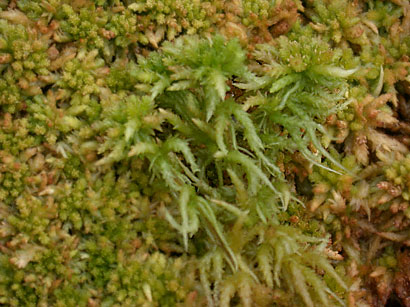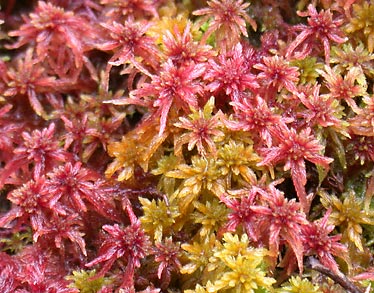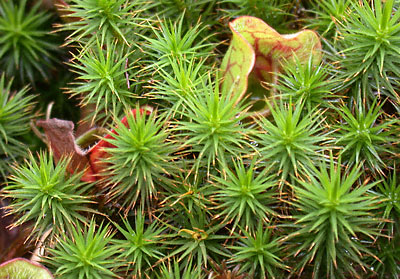|
Mosses, Sphagnum and Polytrichum |
 |
|
 |
|
| Left: a shorter growing Sphagnum which often gets red in cool weather. Above: a more typical form of sphagnum, viewed from above with a few strands pulled out to show habit. |
|
|
| Many types of Sphagnum occur in damp or wet places around the world. Dried or living, it is often used in planting mixes and is a primary component of peat moss. Plugs or pieces of live moss are planted in acidic media to start colonies. Most species prefer cool temperatures and survive freezing. Though more desirable than most other mosses, keep Sphagnum pulled away from the crowns of plants and away from most sundews. Often, tamping the moss down a bit is all that is needed. Some sundews, such as D. adelae, seem to thrive in live sphagnum by growing up through it. Rosetted plants are often lost in thick moss. Flytraps (Dionaea) can also be buried alive by sphagnum. These mosses are good terrarium and outdoor bog garden ground covers, as long as growth is managed. Sphagnums are sensitive to polluted rain or water. We have lost large cultivated sphagnum beds due to the acid rain caused by coal-fired power plants and weak governmental controls on air quality. Test equipment verified the cause of damage. In rare cases, some sphagnum can hold spores of a fungus, pathogenic to humans (Sporothrix schenckii). Do not handle untreated sphagnum if you have open cuts or skin breaks, or if you have a weak immune system. The fungus usually gets in through wounds. Rubber gloves are good for skin protection and wetting dry moss before handling lowers air born dust. Avoid inhaling moss dust. Botanique pasteurizes the moss we use for packing (not live moss, Sporothrix apparently doesn't like live sphagnum), either by heating to a minimum of 160°F for four hours (min.), or by soaking in disinfectant (quaternary ammonium salts) before rinsing, this should kill all spores. Spores can occur on many surfaces, including hay. The only local case of Sporotrichosis I've heard of was a carpenter infected from a wood splinter. Strangely, live sphagnum moss was once used to dress wounds! For more information on Sporothrix and the disease Sporotrichosis visit: www.cdc.gov/ncidod/dbmd/diseaseinfo/sporotrichosis_g.htm. |
|
 |
Polytrichum moss (many species) often appears from wind-blown spores. It is pretty, but it can choke plants if not removed or controlled. Here, a Sarracenia purpurea struggles to ride a green tide. Polytrichum should always be removed from near the crowns of desired plants. Thorough pulling (weeding) can be effective. Grasp only a few at a time, when weeding, to avoid dislodging smaller plants. Polytrichum usually kills sundews! |
|
| Here are some control measures: First, control or remove the moss as it appears; do not ignore it for long. Hand pull small amounts at a time (1-4 stems) around desired plants' crowns. Once the plants you want have a moss-free border around them, other methods can be faster, including: 1.Digging and turning over "sods" of moss so it can't get light. 2.Removing the peat/sand or media with the moss and replacing it. 3.Trimming the moss aggressively with sharp shears or scissors. We actually heat pasteurize cut Polytrichum, chop it into inch-long pieces and use it in some of our Nepenthes media mixes. Since it's dead, it slowly releases nutrients as it decomposes. All species of Nepenthes we have tested, using dead Polytrichum, have responded with better/faster growth (side-by-side trials). 4.We are experimenting with small, weed-burning torches (Not regular, plumber's torches) during damp weather and away from desired plants. So far, the results have been very good. We're using a 20,000 BTU Bernzomatic* that runs on bottled propane. Weed-burning torches may be especially useful in larger areas. Peat and other organic soils can ignite and be hard to extinguish, so be sure to thoroughly saturate the soil beforehand and beware of melting/igniting other objects (like plant labels)! Follow all instructions from the manufacturer. *For now, we're using a torch we got from Northern Tool & Equipment, ph:1-800-556-7885, item#17392-B974. |
|
|
|
|
|
|
|





